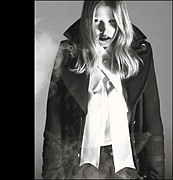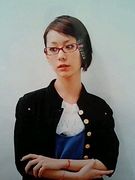- 詳細 2019年9月23日 20:34更新
-
Born in 1927, at the age of seventeen Hubert James Taffin de Givenchy left his birthplace in Beauvais for Paris, at a time when the couturier business was still passed on from master to apprentice. He learned from Jacques Fath, Robert Piguet, Lucien Lelong (recommended by Christian Dior) and in Elsa Schiaparelli’s famous salons on Place Vendôme.
Foreseeing relaxed chic and the democratisation of luxury, which together marked the end of the century, in 1952 Givenchy launched «separates», light skirts and puff-sleeved blouses made from raw cotton – previously reserved for fittings only. Two years later Hubert de Givenchy was the first major fashion designer to present a luxury ready-to-wear line, «Givenchy Université». More than any other, this was a designer who maintained close relations with his famous clients. No surprise there, he wanted to dress women. All women. From Paris to New York, Hubert de Givenchy’s fashions came out of the salons and down into the street. In 1953 one of Hubert de Givenchy’s designs was featured on the cover of Life magazine.
The best dressed women in the world were keen to be part of it – Lauren Bacall, Babe Paley, Greta Garbo, Elizabeth Taylor, Marlène Dietrich, Jacqueline Kennedy-Onassis, Princess Grace of Monaco and Wallis Simpson, for whom the designer created special covers, to preserve the Duchess’s envied orders from prying eyes. They were made in Windsor blue.
In 1953 Hubert de Givenchy received the wrong Miss Hepburn, because it was Audrey Hepburn, and not, as planned, the great Katharine, who arrived for a fitting in a tied-up T-shirt, tight trousers, sandals and a gondolier hat. The result was a relationship that lasted forty years, with the Anglo-American actress playing the role of the designer’s ambassador, both off screen and on, in great classic films such as Sabrina, Breakfast at Tiffany’s and Funny Face.
Hepburn entered the circle of the world’s smartest women and Hubert de Givenchy’s fame spread worldwide. Together the designer and his muse defined a new kind of beauty: exhaustive perfection of lines, narrow hips, willowy body and swan’s neck ….. The sixties ingenuous style was born chez Givenchy.
In 1957, Hubert de Givenchy again made the headlines by using Hepburn to promote his first perfume, L’Interdit. It was the first time that an actress had allowed her face to be used in perfumery. Success was enormous, with the American market immediately won over. This was when the designer’s clientele became almost exclusively Anglo-Saxon.
The information era made Hubert de Givenchy a superstar fashion designer – immortalised by Irving Penn and Richard Avedon, sketched by René Gruau and Christian Bérard – his supreme elegance became in 1973 the ideal example for his men’s fashion line, «Gentleman Givenchy». Even today that look remains a benchmark.
Having delayed launching licences on the advice of his friend and mentor, the legendary designer Cristóbal Balenciaga, Hubert de Givenchy made up his mind to do so in the seventies, to ensure the lasting nature of his costly haute couture collections. The house’s diversification then happened quite naturally with the designer running his aesthete’s eye over collections of table linen, furnishing fabrics, shoes, jewellery and even, in 1976, a car: Ford’s Lincoln Continental.
Hubert de Givenchy travelled widely. From Washington to Tokyo, promotional gala to institutional exhibition, the designer saw things big. And he saw further. He handled globalisation as the perfect man of the world that he is. Givenchy was always a man of his time. In 1988, he felt the wind turn towards major groups, and joined LVMH Louis Vuitton Moët Hennessy at the very time when the world leader in luxury goods started to re-consider the way in which business is run, on the eve of the new millennium.
After retiring in 1995, Hubert de Givenchy was succeeded by young British designers. John Galliano (in January 1996), Alexander McQueen (in October 1996) and Julien MacDonald (in March 2001): three fashion non-conformists, just like Hubert de Givenchy when he first started. In 1956 Hubert de Givenchy was the first designer to present his collections simultaneously to the press and clients. Half a century later the young bloods from over the channel have successfully taken up the baton, with their colourful shows still being written about extensively as they flatter a whole new generation of couture clients.
In December 2003, the British tailor Ozwald Boateng was appointed creative director for Givenchy Homme and in March 2005 the Italian designer Riccardo Tisci was appointed creative director for the Givenchy Femme haute couture and ready-to-wear collections.
Givenchy from 1927 to present
1927
Hubert James Taffin de Givenchy is born in Beauvais, France.
1945
Aged seventeen, inspired by his mother’s glossies, prompted by his seamstress cousins and brimming with youthful exuberance, Hubert de Givenchy leaves Beauvais for Paris. He begins his apprenticeship as a draughtsman for the couturier Jacques Fath.
1946
Hubert de Givenchy is recommended by the celebrated surrealist illustrator Christian Bérard for a design post at Robert Piguet.
1947
Word-of-mouth about the dashing young man at Piguet spreads like wildfire in the hermetic world of Parisian haute couture, and it isn’t long before Hubert de Givenchy leaves Piguet for Lucien Lelong, upon the recommendation of the newly-acquainted Christian Dior. Six months later, illustrator René Gruau puts a word in for Givenchy at Elsa Schiaparelli, where the young man becomes the couturiere’s first assistant and the director of her celebrated Place Vendôme boutique.
1951
After four years of collaboration, Hubert de Givenchy resigns from Schiaparelli, intent on opening his own couture house. The somewhat overbearing couturiere thunderously dismisses him as «yet another bankruptcy».
1952
Hubert de Givenchy opens his own maison at n° 8, rue Alfred de Vigny, overlooking Paris’s Parc Monceau. On February 2nd, he presents his first couture collection, featuring the now famous ‘Bettina’ blouse as a nod to his newly appointed press relations director, the celebrated fifties beauty Bettina Graziani. The collection’s revolutionary concept of ‘separates’- lightweight skirts and billowing blouses- was unheard of in the tightly corseted and heavily embroidered world of haute couture at the time. The couturier’s use of ‘shirting’- a coarse cotton akin to the toile used for fittings - further heralded the casual chic that would come to define the second half of the century. Life magazine features a Givenchy look on its cover. Clients file into the couturier’s gothic salons, which becomes known as ‘the Cathedral’. Early-day supermodels- Suzy Parker, Ivy Nicholson, Capucine- squabble to feature in his shows.
1953
Two decisive encounters:
• Cristóbal Balenciaga, introduced to Hubert de Givenchy at a Condé Nast cocktail in New York. The legendary Spanish couturier praises Givenchy’s organdie scarf pricked with springs of lily of the valley for its youth and freshness. Hubert de Givenchy becomes the charismatic- if not overly sociable- couturier’s closest friend and most long-standing protégé («my adopted son» Balenciaga would say) until Balenciaga’s death in 1972.
• Audrey Hepburn, who flew to Paris for a last minute makeover, her Edith Head-designed wardrobe for Sabrina having failed to please director Billy Wilder. Having been announced a certain «miss Hepburn», Hubert de Givenchy expects the movie’s lead, Katharine Hepburn, at the fitting. Instead, the as yet unknown British actress saunters in wearing black leggings, a knotted T-shirt, flat sandals and a gondolier’s hat, only to swan out with the entirety of Givenchy’s samples for his upcoming presentation. Clean lines, gamine features and long, gracile limbs: the ingénue of the sixties was born at Givenchy. Hepburn wears Givenchy in Sabrina (dir: Billy Wilder; 1954), Love in the Afternoon (dir: Billy Wilder; 1957), Funny Face (dir: Stanley Donen; 1957), Breakfast at Tiffany’s (dir: Blake Edwards; 1961), Charade (dir: Stanley Donen; 1963), Paris when it Sizzles (dir: Richard Quine; 1963), How to Steal a Million Dollars and Live Happily Ever After (dir: William Wyler; 1965) and Bloodline (dir: Terence Young; 1979).
1954
Upon the death of Jacques Fath, French entrepreneur Jean Prouvost asks Hubert de Givenchy to develop the first collection of high-end women’s ready-to-wear to be designed by a couturier. «Jacques Fath Université» thus becomes «Givenchy Université». The line is manufactured in Paris’s 10th arrondissement garment district on industrial sewing machines imported from the United States.
1956
To stall counterfeit, Cristóbal Balenciaga and Hubert de Givenchy take the initiative of presenting their collections simultaneously to the clients and the press. Catwalk shows have been presented this way ever since.
1957
Hubert de Givenchy follows the advice of Balenciaga and launches his own perfumery division «Parfums Givenchy» in spite of repeated offers from american pharmaceutical giants. The fragrances are produced in Balenciaga’s factory on the outskirts of Paris, and the perfumery division is placed under the direction of Hubert de Givenchy’s brother.
Givenchy creates «De», his first women’s fragrance, followed by «L’Interdit», a fragrance inspired by the couturier’s muse, Audrey Hepburn. It’s the first time a couturier banks in on the heady success of a Hollywood A-lister for a fragrance campaign. It’s also the last time a Hollywood heavyweight waives her fees for such an endorsement.
1958
Hubert de Givenchy presents his «baby-doll» collection to critical acclaim.
1961
Launch of Givenchy’s two first men’s fragrances «L’eau de Vétiver» and «Monsieur de Givenchy».
1961
Hubert de Givenchy designs Jacqueline Kennedy’s wardrobe for her state visit to France and dresses her for dinner with president de Gaulle in Versailles. The fittings are cloaked in secrecy: the ever-stylish First Lady is held to wear only American brands, but, true to form, chooses the diplomatic slur over the fashion faux pas. De Gaulle compares her to a Watteau oil painting.
Maison Givenchy moves to n°3, avenue George V, and opens its first Parisian boutique at the same address. Although Hubert de Givenchy first balks at the extravagant cost of his new headquarters, Balenciaga predicts that in two years he will have outgrown his ateliers.
1963
Hubert de Givenchy expands his business and buys out the whole hôtel particulier.
1965
The Givenchy Ball in Houston is the first major exhibition aimed at consolidating Hubert de Givenchy’s stronghold on the American market. Others include the Universal Exhibition in Montréal (1967), a group exhibition in San Antonio, Texas (1968), and a grand-scale tour of Givenchy fashion extravaganzas across the United States (1970).
1968
Launch of the high-end ready-to-wear collection «Givenchy Nouvelle Boutique», in association with French clothing manufacturer Mendès.
1972
The Givenchy ateliers lose sleep over the famous black riding coat that H.R.H. the Duchess Of Windsor orders overnight for the duke’s funeral the next day.
1973
Hubert de Givenchy participates in the prestigious line-up of five French couturiers and five American designers staged by the late Marie Hélène de Rothschild at the Gabriel Theater in Versailles.
Givenchy launches «Gentleman Givenchy», his first men’s ready-to-wear collection. The always impeccably turned-out Hubert de Givenchy, forever on the arm of the world’s most iconic beauties, proves to be his new label’s own best marketing tool.
1978
Givenchy is awarded the Dé d’or, France’s most coveted fashion prize, for his fall/winter collection.
1980
Hubert de Givenchy is voted Personality of the Year 1979 and Most Elegant Man of the Year by The Best.
French president Valéry Giscard d’Estaing personally opposes the sale of «Parfums Givenchy» to a British conglomerate, as part of his agenda to protect French cultural heritage.
1981
«Parfums Givenchy» is sold to Veuve Clicquot champagnes.
1982
Givenchy is awarded his second Dé d’or for his spring/summer collection.
A retrospective of thirty years of design, presided by Audrey Hepburn, is staged for Givenchy at New York’s Fashion Institute of Technology.
1983
Hubert de Givenchy is knighted Chevalier de la Légion d’Honneur.
1984
Launch of the women’s fragrance «Ysatis». The streamlined bottle is inspired by the New York skyline.
1985
French minister of culture Jacques Lang awards Hubert de Givenchy with the Oscar of Elegance during a ceremony at the Paris Opera.
1988
Givenchy Couture is sold to luxury goods group LVMH Moët Hennessy Louis Vuitton, following the group’s acquisition of Veuve Clicquot and Parfums Givenchy.
1991
A lavish retrospective spanning forty years of creation is staged at Paris’s Galliera Museum of Fashion and Costume.
Launch of the women’s fragrance «Amarige».
1992
Former mayor of Paris and current French President awards Hubert de Givenchy with the medal of Arts et des Lettres.
«Givenchy Nouvelle Boutique» becomes «Couture Givenchy».
1995
Hubert de Givenchy retires from the house he founded forty-three years earlier.
1996
On January 1st, British designer John Galliano is appointed as head designer of Givenchy’s haute couture and ready-to-wear lines.
On October 14th, John Galliano departs for Dior and is replaced at the helm of Givenchy by fellow British Designer of the Year and enfant terrible Alexander McQueen.
Launch of the women’s fragrance «Organza».
1999
«Gentleman Givenchy», «Couture Givenchy» and «Haute Couture» are consolidated under the single brand name «Givenchy».
Launch of the men’s fragrance «π».
2000
Launch of two women’s fragrances: «Oblique» and «Hot Couture».
2001
In March, Julien Macdonald is appointed as creative director of Givenchy.
2003
Liv Tyler becomes the face of the new women’s fragrance «Very Irresistible Givenchy».
On December 8th, British tailor Ozwald Boateng is appointed as creative director of the Givenchy men’s division (ready-to-wear and accessories). He designed his first collection Spring/summer for Givenchy in july 2005.
2005
On February 28th, Italian designer Riccardo Tisci is appointed as creative director of the haute couture, ready-to-wear and accessories lines. He designed his first collection haute couture for Givenchy in july 2005.
http://www.giv enchy.f r/












